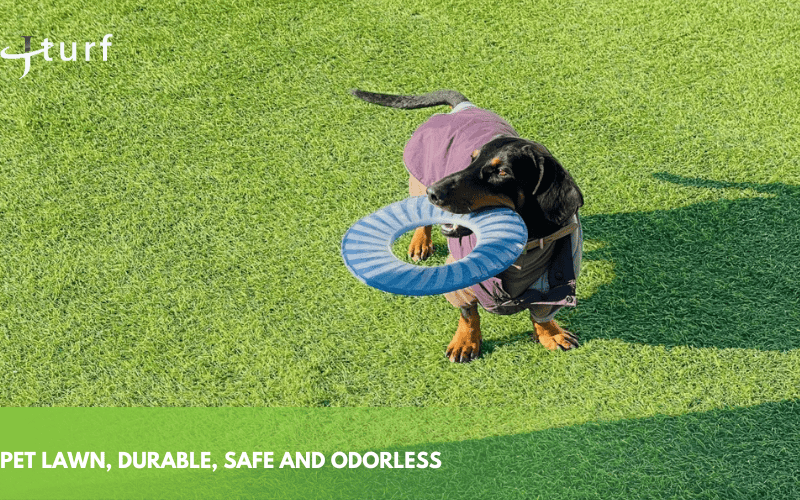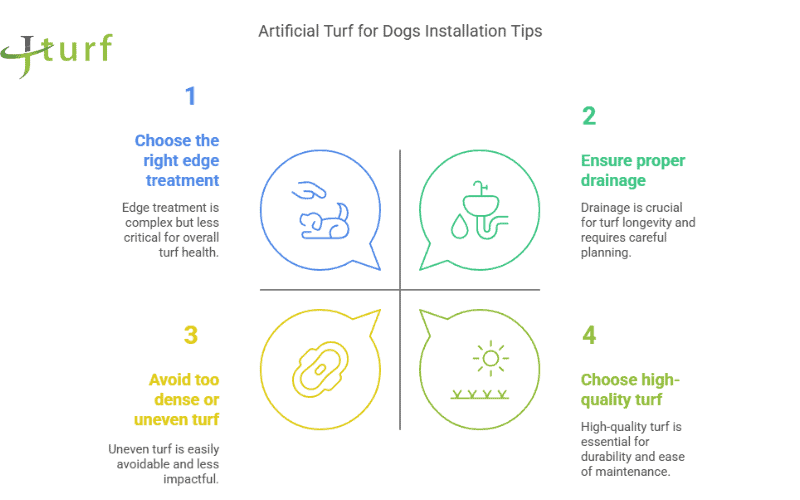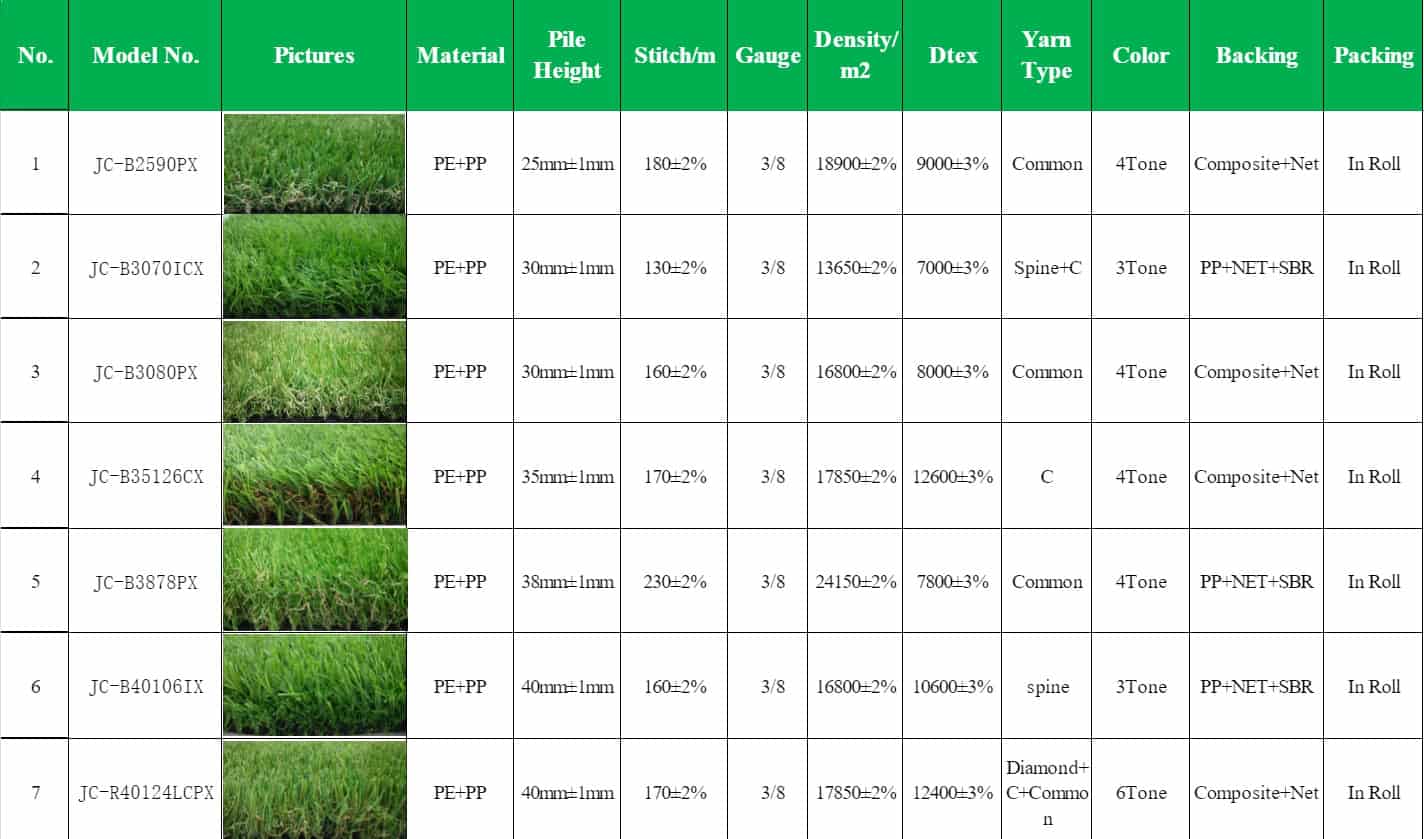Yes, artificial grass serves as an excellent option for dogs, given its durability, ease of maintenance, and ability to provide a tidy, hassle-free play area for them. Unlike natural grass, it doesn’t leave muddy marks and doesn’t need to be watered as often, making it a perfect choice for active dogs.
In this article, we’ll cover the pros and cons of artificial grass for dogs, discuss common problems, and provide some maintenance tips to ensure the grass is safe and fresh for your pet.
Is Artificial Grass Safe for Dogs?
Yes, high-quality pet-specific turf is made from non-toxic, lead-free materials like nylon or polypropylene, similar to children’s toys. These durable materials withstand wear from dogs playing, ensuring safety for their paws and joints.
Pros and Cons of Artificial Grass with Dogs
Benefits of Artificial Grass with Dogs
Cleanliness and Maintenance
- Mud-Free Environment: Artificial grass remains clean and dry, eliminating muddy paw prints in your home.
- Easy to Clean: Waste and urine can be rinsed away effortlessly.
- Low Maintenance: It requires no mowing, watering, or fertilizing, which saves time and effort.
- No Digging: Dogs are unable to dig through it, preventing unsightly holes and damage to the lawn.
Health and Safety
- Fewer Allergies and Pests: It does not attract fleas, ticks, or allergens commonly found in natural grass.
- Reduced Chemical Use: There’s no need for pesticides or fertilizers, making it safer for pets.
- Safer Surface: The soft and even texture is gentler on dogs’ paws and joints, lowering the risk of injury.
Durability and Longevity
- Withstands Active Play: Engineered to endure the wear and tear from dogs running, jumping, and playing.
- Long-lasting: High-quality turf can last for many years, offering a robust solution.
Cost-Effectiveness: Although the initial investment may be higher, reduced maintenance and water usage can lead to significant savings in the long run.
Additional Benefits
- Visual Appeal: Maintains a consistently green and attractive appearance, even in areas with heavy foot traffic.
- Flexible Design Options: Can be customized in various layouts and designs, providing more versatility than natural grass.
Cons of Artificial Grass with Dogs
Safety Risks: Artificial turf can get extremely hot in direct sunlight, risking burns to dogs’ paws. The surface can also be slippery when wet, increasing the chance of skidding and injuries.
Cleaning Difficulties: Pet urine is challenging to clean, leading to lingering odors as it breaks down into ammonia. While solid waste can be easily picked up, urine may seep into the infill, creating long-term sanitation issues. Regular rinsing is necessary to minimize odors and bacteria.
Health Concerns: Some dogs may develop skin irritations or hot spots from the synthetic fibers, especially those with sensitive skin. Additionally, dogs might need time to adjust to the unfamiliar texture.
Environmental Considerations: Although artificial grass reduces the need for watering and pesticides, it can negatively affect the soil beneath it. Its eco-friendliness is questionable, particularly regarding lifespan and potential replacement. Some infill materials may also contribute to odors or pose health risks if ingested.
Financial Implications: The initial installation cost of artificial grass can be significant, making it a considerable financial decision for pet owners.
Common Concerns About Artificial Grass for Dogs
Can Dogs Pee and Poop on Artificial Turf?
Yes, dogs can definitely do their business on artificial grass. In fact, it’s designed to handle it! The surface is built to let urine drain through, and it’s easy to scoop up poop. However, there’s one thing you should keep in mind: if you don’t clean up right away, waste can sit on the turf, which may lead to odors or stains.
But there’s no need to fret—it’s a straightforward solution. Simply gather up the solid waste and promptly rinse the area with water. Keeping things clean regularly will help maintain a fresh environment for your dog.
Does Dog Pee Damage Turf?
Dog urine won’t actually “damage” artificial grass in the way it might harm natural grass. But if left untreated, it can lead to unpleasant smells or even some discoloration over time.
A good drainage system will allow urine to flow through, and rinsing the turf every so often will keep it looking good. Plus, you can use a deodorizer or turf sanitizer to help tackle any lingering odors and keep your turf in top shape.
How to Clean Dog Poop off of Artificial Turf?
Cleaning dog poop off artificial grass is pretty simple. Just grab a scoop or bag, pick up the solid waste, and you’re almost done! To make sure the area stays sanitary, rinse the spot with water.
To achieve a more comprehensive cleaning, you have the option of using a gentle soap solution or a dedicated turf cleanser. Additionally, routine brushing not only maintains the upright position of the grass blades but also prevents debris buildup, ensuring your turf remains vibrant and clean.
How Do I Stop My Artificial Grass from Smelling of Dog Urine?
When urine sits on the turf for too long, it can build up and start to smell. To avoid this, rinse the turf frequently, especially in high-use areas. A deodorizing spray formulated for pets can also effectively freshen the area. And of course, make sure your grass has a good drainage system so urine can flow through easily, preventing it from pooling and causing odors.

Installation Tips for Artificial Grass with Dogs
When you’re installing artificial grass for your dog, there are a few important things to keep in mind to make sure it’s safe, durable, and easy to maintain.
Choose the right type of turf
High-quality turf: It is important to choose an artificial turf that is suitable for pets. The ideal turf should be durable, hard-wearing, and UV-resistant to ensure that it does not fade when exposed to the sun for a long time. Some turfs also have antimicrobial treatments, which is particularly important in pet areas to help reduce the growth of bacteria and odors.
Density of turf: Make sure the turf you choose is of moderate density to provide a comfortable surface for your pets to use, while preventing it from flattening due to frequent trampling.
Ensure proper drainage
Drainage is a core consideration when installing artificial turf. Even if the base material is permeable, it is important to ensure that there are enough drainage holes on the upper surface of the turf to avoid water accumulation. Water accumulation will not only cause the turf surface to smell, but it may also cause the turf to become soft and affect its service life.
Slope design: Make sure the turf has the appropriate slope when installing so that water can flow smoothly to the drainage system. The ideal slope is usually a 1-2% incline to ensure that water does not accumulate on the turf surface.
Avoid too dense or uneven turf
Turf laying: Make sure the artificial turf is laid evenly to avoid bubbles or wrinkles, especially in areas where dogs often move around. Uneven turf laying may cause the turf to loosen or wrinkle when dogs scratch or jump.
Fix turf seams: Be careful to handle the seams of the turf during installation to ensure that they are flat and seamless. This not only improves the aesthetics, but also prevents damage to the turf caused by dogs scratching or running.
Choose the right edge treatment
Edge fixing: The edges of the turf need to be fixed with appropriate fixing materials, such as lawn spikes, tape, or other methods to ensure that the turf is stable and does not shift or lift over time.
Prevent dogs from scratching the edges: To ensure the turf maintains its appearance and prevents dogs from grabbing or pulling it, make sure the edges are neatly and firmly fixed.
What is the Best Thing to Put Under Artificial Grass for Dogs?
The base layer acts as the foundation for your turf, ensuring proper drainage and preventing any water buildup that could lead to unpleasant odors or bacteria growth.
Base Options: The best base materials include crushed stone or granite for excellent drainage and compaction. Decomposed granite (DG) offers stability and effective drainage, while Class II road base, though ideal, can be difficult to source for DIY projects.
Weed membrane: Optional, prevents weeds from invading the artificial turf and should be breathable to allow for drainage.
Infill Options:Silica sand is commonly used for infill due to its soft texture, enhancing drainage and minimizing odors. Consider pet-friendly, non-toxic, and antimicrobial infills to neutralize smells from pet waste, ensuring a clean environment for your pets.
Drainage Solutions
For areas prone to water accumulation, effective drainage solutions are crucial. Options include:
- French Drains: These channel water away from the surface, preventing pooling.
- Perforated Pipes: Installing these beneath the surface helps manage excess water and keeps the area dry.
By focusing on these components, you can create a safe and pleasant environment for your pets.

How to Maintain Artificial Grass for Dogs
When you’ve invested in artificial grass for your dog, maintaining it properly is key to keeping it safe, clean, and looking great for years to come.
Scoop Solid Waste Regularly: Just as with natural grass, promptly removing solid waste ensures prevention of staining and bacterial buildup on artificial turf.
Rinse the Turf: Regularly rinsing the artificial grass with water effectively removes any lingering urine or dirt, aids in preserving a fresh scent, and helps deter the accumulation of unpleasant odors.
Occasional Deep Cleaning: Use a pet-safe turf cleaner or a mild soap solution for occasional deep cleaning to sanitize the grass and eliminate any accumulated bacteria.
Maintaining Drainage
Drainage helps urine and rainwater pass through the turf without pooling on the surface. Without it, moisture can accumulate under the grass, leading to odor, bacteria, or even mold.
Regularly check for standing water, especially after rain or pet use. If water doesn’t drain well, clear the drainage holes or adjust the base material to ensure smooth flow.
By keeping the drainage system clear, you’re preventing potential odor issues and ensuring that your turf lasts longer while providing a hygienic area for your dog to play.
How Long Does Artificial Grass Last with Dogs?
Artificial grass has a lifespan ranging from 8 to 15 years, even when subjected to heavy use by dogs. The durability of your turf is primarily contingent upon the quality of the materials employed, the level of usage, and the degree of maintenance it receives.
Premium, pet-compatible artificial grass is engineered to endure the rigors of running, playing, and even sporadic digging. However, regular maintenance—like rinsing urine off, picking up waste promptly, and keeping the drainage system clear—will help extend the life of your turf and keep it looking fresh.
While dogs might cause some areas to wear down faster, especially in high-traffic spots, artificial grass generally outperforms natural grass in terms of durability and longevity, offering a long-term solution for pet owners.
When Artificial Grass is Not Ideal for Dogs
| Situation | Why It’s Not Ideal |
| Large or Highly Active Dogs | If your dog is very active, running and digging frequently, the artificial grass may wear down quicker and require repairs due to heavy usage. |
| Dogs That Dig Excessively | Dogs with a digging habit can damage the turf, loosen edges, or even interfere with the drainage system, which may lead to further issues with stability. |
| Budget Constraints | While artificial grass is durable, it comes with a high initial cost for installation. This may not be ideal for those on a tighter budget, even though it’s cost-effective in the long run. |
| Extremely Hot Climates | In regions with intense sun, artificial grass can absorb and retain heat, making it uncomfortable for your dog to walk or lie on during peak summer temperatures. |
Top Pet-Friendly Artificial Grass Supplier
At JCturf, we pride ourselves on being a leading supplier and manufacturer of high-quality artificial grass designed to meet the needs of pets and their owners. With our durable, low-maintenance turf, your dog can enjoy a safe, clean, and comfortable environment all year round. Our artificial grass is crafted using non-toxic materials, ensuring it’s both safe and durable, even for the most active pets.
Whether you’re looking to create a pet-friendly play area or enhance your yard with low-maintenance turf, we offer a wide range of synthetic grass options tailored to your specific needs. Our team is committed to providing top-notch customer service, expert installation guidance, and ongoing support.Get started today by exploring our collection of pet-safe artificial grass. Contact us for a quote, or browse our selection to find the perfect match for your home.



